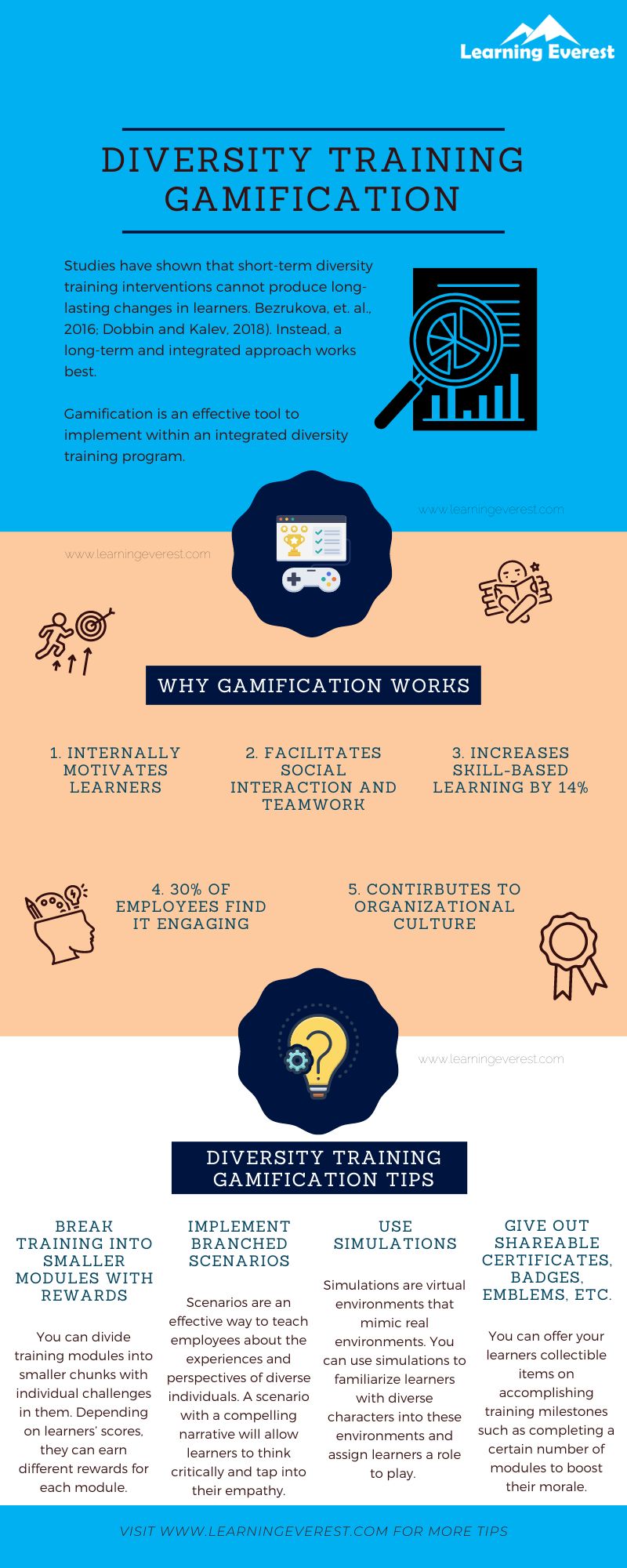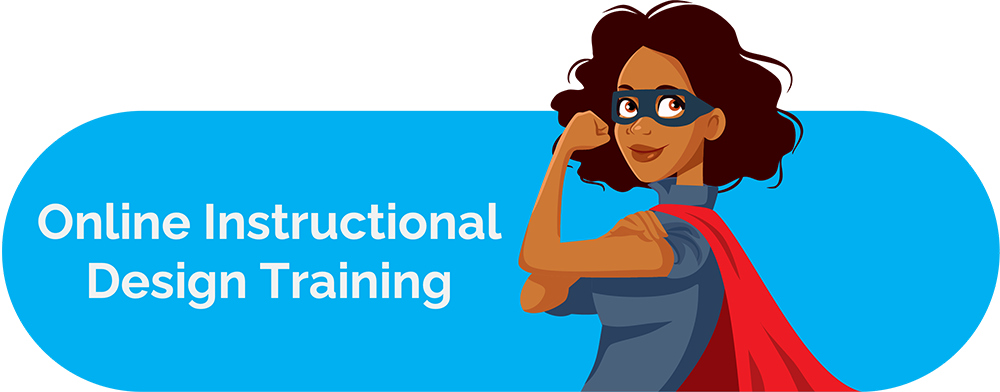Diversity training gamification can transform your DEI initiatives into engaging experiences for employees. Topics related to diversity need to be handled tactfully in organizational training lest they end up causing more harm than good. Therefore, it is always encouraged to use meaningful training strategies that tap into learners’ empathy and internal motivation. Gamification is an e-learning technique that’s very effective at developing skills and behaviors in a highly engaging manner. In this article, you will find out how diversity training can be delivered using gamification.
Table of Contents
- Defining Diversity Training and Diversity Training Gamification
- Why is Diversity Training Gamification Needed?
- Tips to Implement Diversity Training Gamification
- Infographic
- Conclusion
- Frequently Asked Questions (FAQs)
- What are the drawbacks of diversity training?
- What is gamification?
- What are some strategies for diversity training gamification?
- References
Defining Diversity Training and Diversity Training Gamification
Diversity training builds awareness among employees about the experiences and challenges people from different backgrounds and communities might encounter in the workplace. It seeks to foster empathy and inclusion by making people aware of their own unconscious biases.
Gamification is a strategy that applies game elements and principles in a non-game environment. In gamification, users get clear prompts and directions and instant feedback about their actions. This loop makes gamified activities engaging and interesting.
When combined with diversity training, gamification becomes an effective tool that can create desired changes in learners without making it feel forced.
Why is Diversity Training Gamification Needed?
The impact of diversity training depends largely on the mindset of the learners. The wrong approach can lead to short-term effects and even negative responses in some cases.
According to a meta-analysis by Bezrukova, et. al. (2016), standalone diversity training classes and workshops are not very effective. Instead, an integrated approach that spans over a longer period of time is best at building a knowledge base and skills.
The ineffectiveness of short-term interventions is also mentioned in a review by Dobbin and Kalev (2018), as their duration is not enough to permanently change learners’ attitudes and beliefs. Some other factors that hold diversity training back according to the same study are:
- The activation of stereotypes – anti-bias training, which is a common part of diversity training curriculums, can end up making people more aware of stereotypes. Additionally, being asked to suppress stereotypes has a reinforcing effect, instead.
- Employees becoming complacent – employees who have received diversity training or view their employers as non-discriminatory are less likely to conceal their bias. People in pro-diversity workplaces also do not take well to claims of discrimination and tend to ignore hard evidence for the same.
- White people feeling left out – adopting a multicultural or colorblind stance makes white people in the organization feel left out. Their identity feels threatened and alienated under such circumstances, making them resistant or even hostile to diversity training.
- Perceived attempts at exerting external control on people’s thoughts, beliefs, and actions – if the goals and rationale for diversity training and inclusive behavior are framed using external motivators, learners might perceive it as an attempt to control their autonomy. This makes them averse to diversity training. Instead, diversity training should be framed by appealing to internal motivators such as business performance, etc.
Diversity training gamification is not an end-all solution, but it checks quite a few boxes. As mentioned previously, an integrated and prolonged approach works best. Gamification is just one tool that makes the delivery more palatable. So which are these boxes diversity training gamification checks?
- Internally motivates learners – diversity training gamification creates an opportunity to reframe pro-inclusion prompts in a fun and engaging manner. Instead of highlighting large-scale consequences, you can adapt them to gamified scenarios and challenges. This way, learners will have immediate stakes in an enjoyable activity.
- Facilitates social interaction and teamwork – gamified learning can be turned into a social activity. Some common ways to do this are leaderboards and anonymous multiplayer teams. This promotes teamwork and also creates a sense of community. This can be especially engaging for learners who fear the loss of their identity as a result of inclusion. Diversity training gamification allows them an avenue to forge a broader sense of belongingness that goes beyond factors such as ethnicity.
- Gamification is excellent for skill-building – skill-building is an important aspect of diversity training. Actionable skills allow learners to effectively demonstrate inclusive and pro-diversity behaviors. A study by the University of Colorado, gamification has been shown to increase skill-based assessment and factual knowledge scores by 14% and 11% respectively.
- Gamification is engaging – 30% of employees have reported finding gamification more engaging. Engaging learning sessions also make for a psychologically pleasant experience. Therefore, diversity training gamification is a great strategy for engaging learners in a pleasant manner. Natural engagement also leads to better learning because learners’ mental states influence how they receive information at any given moment.
- Diversity training gamification contributes to organizational culture – engaging learning formats can be effective drivers of organizational culture. Thus, diversity training gamification can help you build an organization-wide culture of diversity and inclusion.
Additionally, usage statistics from gamified diversity training can give organizations and trainers a look into what’s working and what isn’t. Based on this, further changes and adjustments can be made to training programs.
Tips to Implement Diversity Training Gamification
Diversity training gamification turns learners from passive observers and listeners to active participants in the learning experience. Here are some gamification strategies you can implement in your diversity training programs:
- Break trainings into smaller modules with rewards – you can divide training modules into smaller chunks with individual challenges in them. These challenges could be question-and-answer activities, MCQs, fill-in-the-blanks, drag-and-drop exercises, etc. Depending on learners’ scores on these questions, they can earn different rewards for each module, such as stars, points, levels, etc. Doing so will incentivize progression and motivate learners to complete courses. Additionally, adding challenges will nudge them to pay attention to course content, ensuring they aren’t just passively consuming it.
- Implement branched scenarios – scenarios are an effective way to teach employees about the experiences and perspectives of diverse individuals. A scenario with a compelling narrative will allow learners to think critically and tap into their empathy, allowing them to connect with the larger group a character represents by getting to know their experience. One of the best strategies to gamify scenarios is by branching them. Branching presents learners with different choices at certain stages of the activity. The ultimate outcome of the scenario depends on the choices made. In this way, branching provides an opportunity for learners to reflect on these choices in a safe environment and apply them to the real world.
- Use simulations – simulations are virtual environments that mimic real environments. You can use simulations to create rich ecosystems which learners can explore. You can add diverse characters into these environments and assign learners a role to play. Through this roleplay, they can change the virtual environment based on their existing diversity and inclusion knowledge and skill set. For instance, learners can roleplay as a decision maker and create diversity and inclusion policies for the virtual environment. Simulations are valuable practice opportunities and help learners feel prepared to use the behaviors they learned during the training in the real world.
- Give out shareable certificates, badges, emblems, etc. – you can offer your learners collectible items on accomplishing training milestones such as completing a certain number of modules to boost their morale. Making these collectible rewards shareable via office channels, social media, LMS dashboards, etc. will add an extra layer of motivation and a social component to your training efforts. This will also boost morale, engage employees, and lower resistance to diversity training, if any.
Infographic
Conclusion
Diversity training gamification is an effective tool for bypassing some common challenges diversity training presents. By gamifying your diversity modules, you can engage learners, internally motivate them, and offer them tangible rewards that create a sense of accomplishment. Integrating this into a more rigorous diversity framework can help produce long-lasting changes in employees’ behaviors and attitudes towards diverse groups, allowing your organization to enjoy the benefits that come with an inclusive workforce.
Frequently Asked Questions (FAQs)
What are the drawbacks of diversity training?
Diversity training can sometimes produce the opposite effect in learners, such as:
- Activation of stereotypes by bringing them to learners’ consciousness
- Making employees complacent as diversity training efforts make them unwilling to acknowledge diversity issues can still exist
- Causing white people (or other majority groups) to feel left out
- Seeming like an attempt to externally control learners’ thoughts, feelings, and attitudes
What is gamification?
Gamification is a strategy that applies game elements and principles in a non-game environment. In gamification, users get clear prompts and directions and instant feedback about their actions. This loop makes gamified activities engaging and interesting.
What are some strategies for diversity training gamification?
Some strategies for diversity training gamification are:
- Break trainings into smaller modules with rewards
- Implement branches scenarios
- Use simulations
- Give out shareable certificates, badges, emblems, etc.
References
- https://scholar.harvard.edu/files/dobbin/files/an2018.pdf
- https://www.zippia.com/advice/gamification-statistics/






